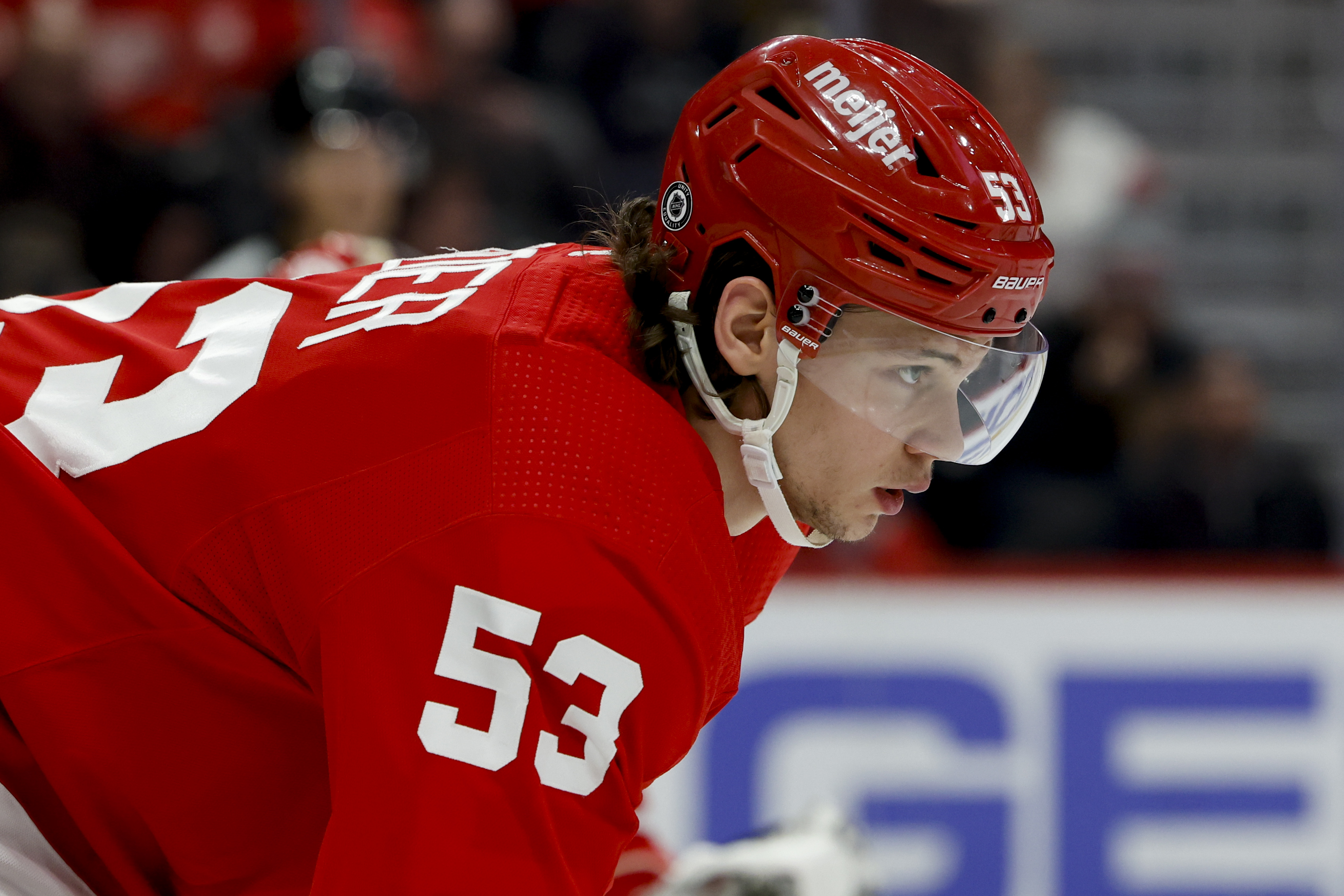
Derek Lalonde noted the pervading negativity in the press concerning Detroit's playoff chances. Where does that negativity come from, and how might the Red Wings prove those projections wrong?
Derek Lalonde noted the pervading negativity in the press concerning Detroit's playoff chances. Where does that negativity come from, and how might the Red Wings prove those projections wrong?

On the final day of Red Wings training camp, head coach Derek Lalonde was asked about calibrating expectations for his team after a busy offseason. Lalonde's answer showed simultaneous hints of optimism, frustration, and realism:
"You try to push the noise away—and that's the media. But the media does it for us. It's not a knock on our guys. I've stopped reading media because it's so negative on us—and it's not a negative on us—The projections, the percentages, some people have us with no chance of making the playoffs. The highest article I read is a 14% chance to make the playoffs. Everyone's writing us off, and again I get it's not a knock on our guys, it's just the reality of the division and the conference that it's in. We'll knock the noise away, and it'll be about our process, just doing things correctly. Very similar to where we were last year. No one gave us a fighting chance last year, and ultimately in the end, they were right. But, as I've stated before, late into the season, game 57, we were in that playoff line, we'd exceeded expectations, and hopefully it'll look the same this year."
If nothing else, the answer was honest, human in its vulnerability.
Like his boss Steve Yzerman, Lalonde isn't standing before the media, beating his chest and declaring that a new golden age is dawning in Hockeytown, one that will surely conclude with a '24 postseason berth and a Stanley Cup parade down Woodward Avenue by '26 at the latest.
Instead, Lalonde does not doubt the prognosticators who have expressed their skepticism of his team's playoff chances and embraces the context in which his team will make its push back toward the postseason: An Atlantic Division loaded with talent, experience, and championship pedigree.
The division could send anywhere from three to five teams to the postseason, and at least seven of its eight constituents have credible playoff aspirations, which is to say disappointment is inevitable for somebody.
By declining to issue a bold proclamation about his team's prospects with respect to the '24 postseason, Lalonde's words seem to work at once to temper expectations amongst a fan base desperate for a return to the playoffs and to embrace the type of "us against the world" mindset entirely familiar within the realm of high-level athletics.
But let's take a moment to dive a bit deeper into some of these (negative) prognostications. Where are these negative outlooks coming from, and what is the source of the pessimism? What reason is there, if any, to believe that Detroit might outpace these estimations?
The specific article Lalonde appears to reference comes from The Athletic, where Shayna Goldman, Dom Luszczyszyn, and Sean Gentille combined to write a data-driven season preview and Luszczyszyn's model (more on this in a moment) gave Detroit a 14% chance at cracking the 2024 playoffs.
However, The Athletic is not alone in its skepticism about the Red Wings' playoff chances.
The Hockey News' own Adam Proteau categorized Detroit among his list of three NHL teams whose upgraded roster still aren't playoff-worthy. Proteau commended Steve Yzerman for adding "skill and grit" to his team's line-up but concluded that "The Red Wings need all the stars to line up perfectly to be a post-season team in 2023-24. As we all know, very rarely do all the stars line up perfectly for any team."
Bet MGM lists the Red Wings at +5000 to win the Stanley Cup. That puts Detroit as the book's 18th favorite candidate for that distinction, just outside the playoff mix and behind divisional rivals Toronto, Tampa Bay, Boston, Florida, Buffalo, and Ottawa.
As Lalonde himself noted rather than disputed, "the reality of the division and conference" is that the Red Wings are not favorites to qualify for the postseason, even among those who believe Detroit did make significant improvements this offseason.
None of Toronto, Tampa, Boston, or Florida will want to relinquish their '23 playoff berths, while Ottawa and Buffalo have revamped in their own ways to make the exact sort of leap the Red Wings are seeking. Simply put, it's a crowded field.
To get a bit more specific about the sources of this negativity, let's take a closer look at The Athletic's projection.
Luszczyszyn has been fine-tuning his model since he launched in 2016. The latest iteration updates his previous "Game Score" system to separate out offensive impacts from defensive ones.
He introduces "offensive rating" as "A weighted combination of goals, primary assists, secondary assists, individual expected goals, faceoffs, penalties drawn, expected goals for impact at five-on-five, goals for impact at five-on-five, power-play goal impact and usage" and "defensive rating" as "A weighted combination of blocked shots, faceoffs, penalties taken, expected goals against impact at five-on-five, goals against impact at five-on-five, penalty kill impact and usage."
Per Luszczyszyn, the change allows the model to better account for stylistic differences between teams without privileging teams that play at a high pace.
Using that model, Luszczyszyn has Detroit rated as the NHL's 21st best offensive team and 21st ranked defensive team. That works out to a "net rating" that places the Red Wings as the 23rd best team in the NHL heading into the new season, which is to say comfortably outside a playoff spot.
As a supplement to Luszczyszyn's model, the article mentions that "The best thing Detroit has going for it is the best-supporting cast it’s had in years." Luszczyszyn, Goldman, and Gentille praise the acquisition of Alex DeBrincat as filling a precise void at the top of the Red Wings' line-up. However, the trio also question whether a team with DeBrincat and Dylan Larkin as it two best forwards can make the playoffs.
Ultimately, they conclude with the following: "This is, no doubt, the best team we’ve seen in Detroit since Yzerman took the reigns. He isn’t the only one with a plan, though. Other teams have spent the last few years getting better too, both in the Eastern Conference and in Detroit’s own division, and they seem to be farther down the road to relevance."
So, for Red Wing fans, what reason might their be for optimism in the face of this empirical skepticism?
If there's one hope I can identify here, it lies in the idea that Luszczyszyn's model (which, as I understand it, operates based on the sum total of the individual parts of each team's roster) cannot quite appreciate the significance of Detroit's added depth.
Take J.T. Compher as an example. He was the Red Wing's premier free agent acquisition, but bringing him to Detroit was less about lighting up the score sheet than it was reinforces the team's overall solidity. Compher is not an elite offensive player by any stretch, but he is a player who commands all 200 feet of the rink when he's on the ice. Spending 2022 and '23 first round picks on Nate Danielson and Marco Kasper reflects a similar emphasis on solidity over offensive panache.
This prioritization, of course, constitutes a gamble, but it's the bet the Yzerman regime is making in its bid to not just qualify for the playoffs once but to build a sustainable contender.
Through last year, the teams Yzerman has overseen in Detroit have not had four lines' and three defense pairs' worth of credible NHL players. That dynamic is bound to leave massive vulnerabilities to a team's structure. By plugging those holes with players like Compher, Christian Fischer, and Daniel Sprong up front and blue liners like Jeff Petry and Justin Holl, the Red Wings have taken a major step toward rectifying that problem (as The Athletic notes).
The hope for Detroit fans would be that extra solidity will improve the overall performance of each member of the team, with star players less burdened by carrying excessive weight and role players more fittingly slotted into the line up. However, you wouldn't necessarily expect a model to be able to account for that dynamic (an overall boost to everyone's performance based on a step forward in, for lack of a better term, competence in the bottom half of the line-up).
So, what's the best bet for Detroit to outperform expectations and push to the 2024 postseason and beyond?
As Proteau notes, it will have to involve a lot of things going right, given the competitive field in the Atlantic Division. DeBrincat needs to click quickly. Larkin needs to continue his maturation into one of the NHL's most dynamic 200-foot players. Lalonde needs to find the right role for the new depth players.
However, most of all, Detroit needs to see continued growth in overall stability, a process Lalonde began a year ago. If the Red Wings can consistently carry play on the strength of their quality of depth, they can overcome a deficiency (perceived or real) in top-end talent relative to the rest of the Atlantic.

